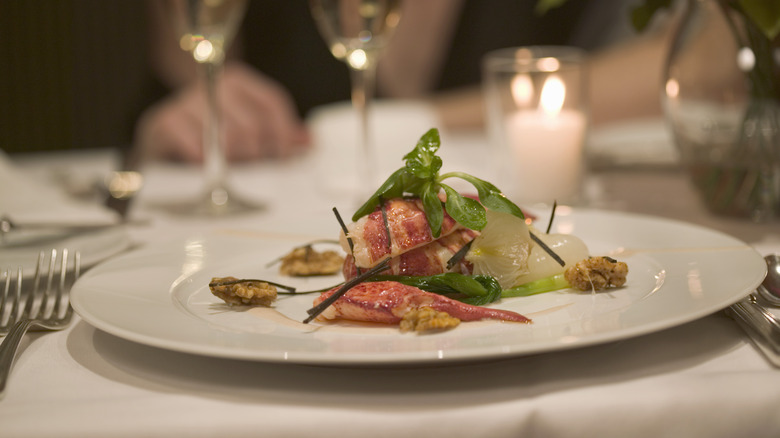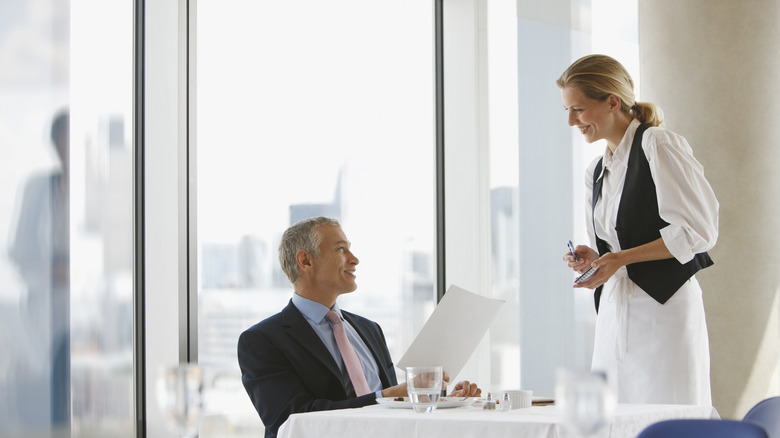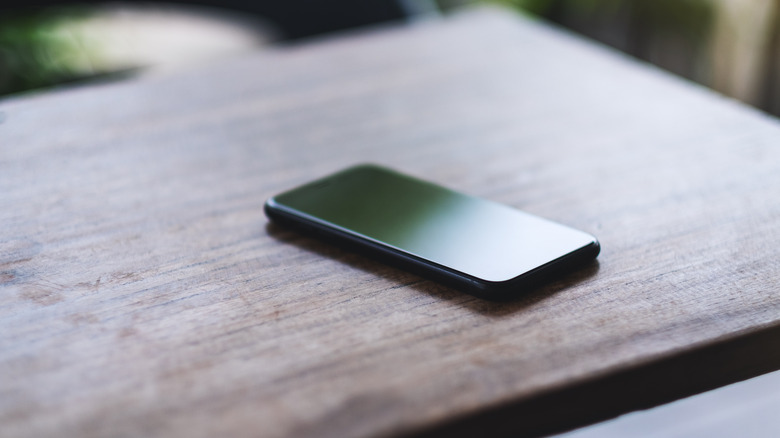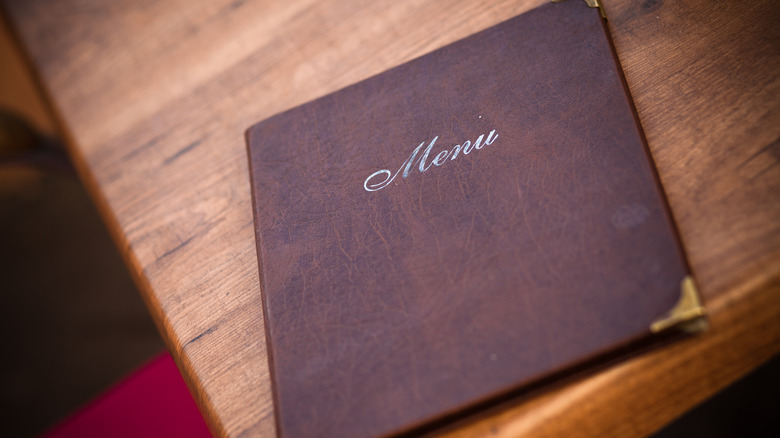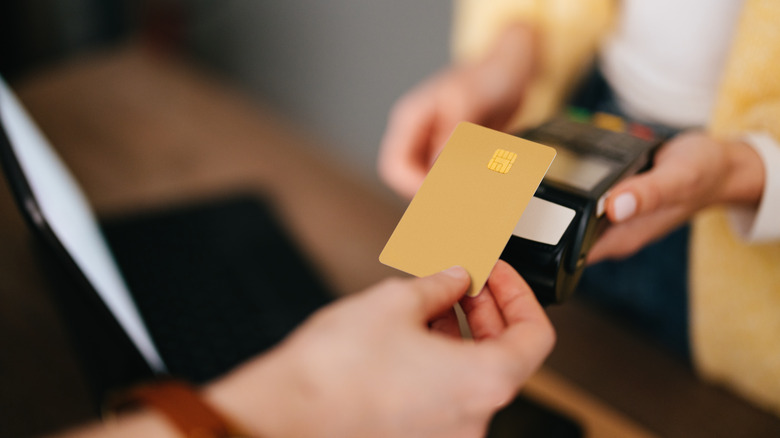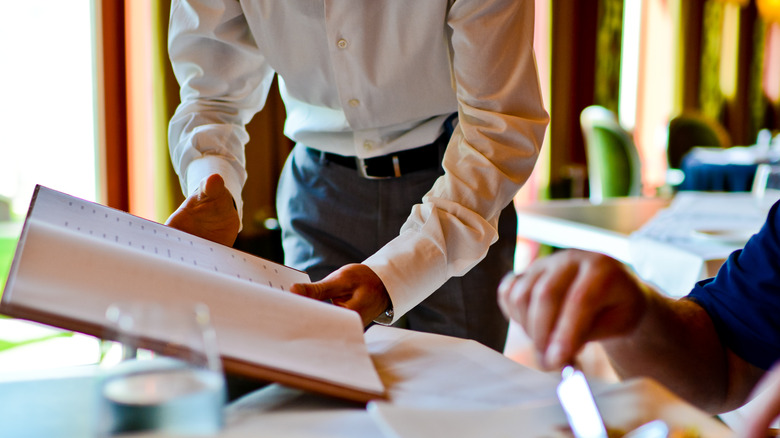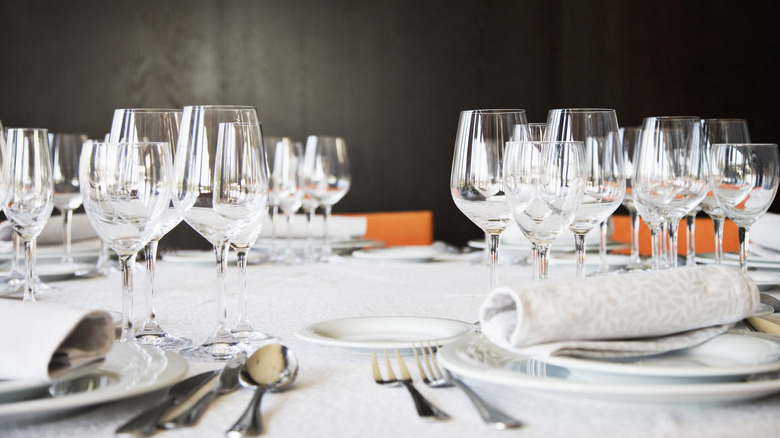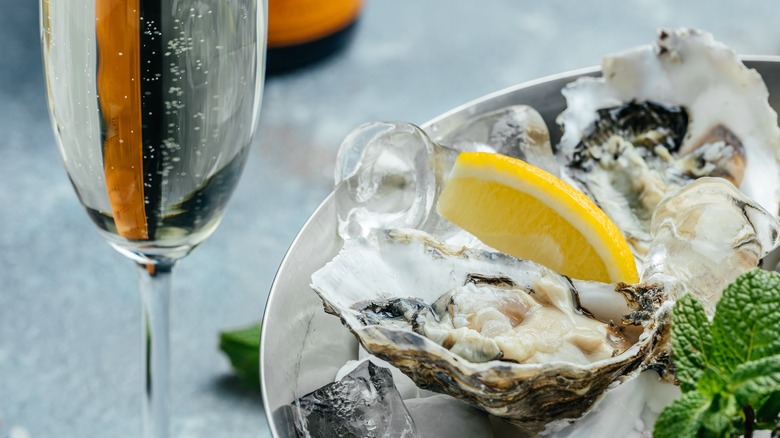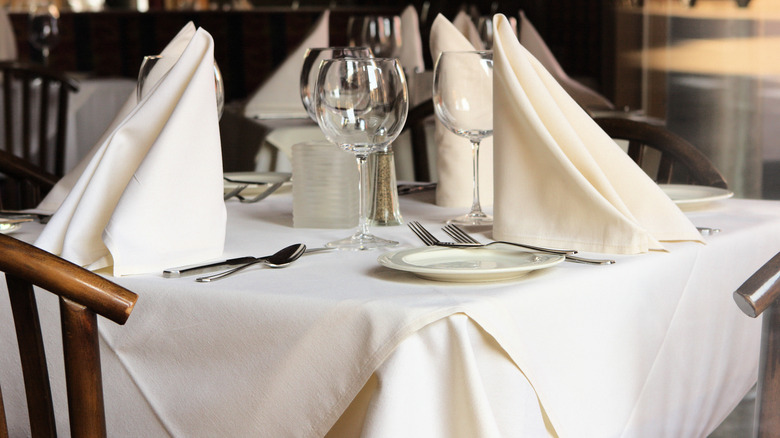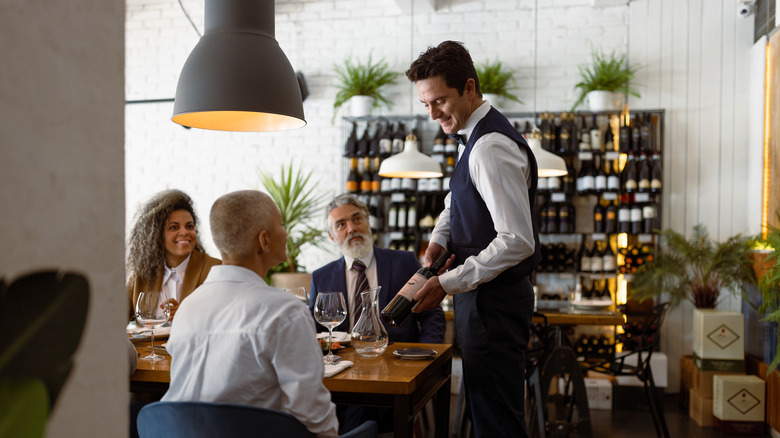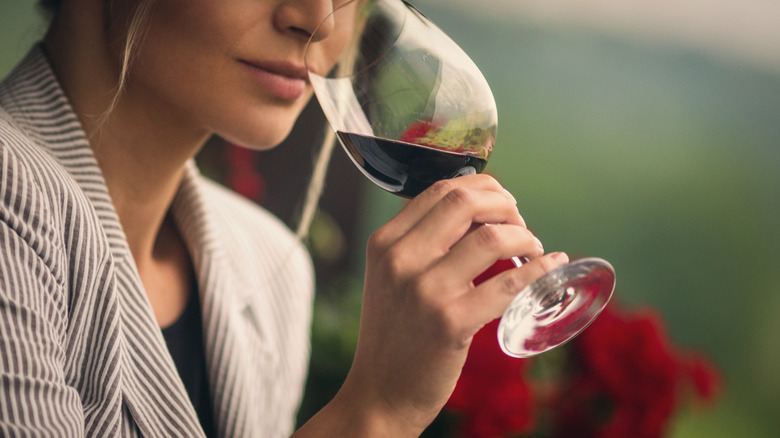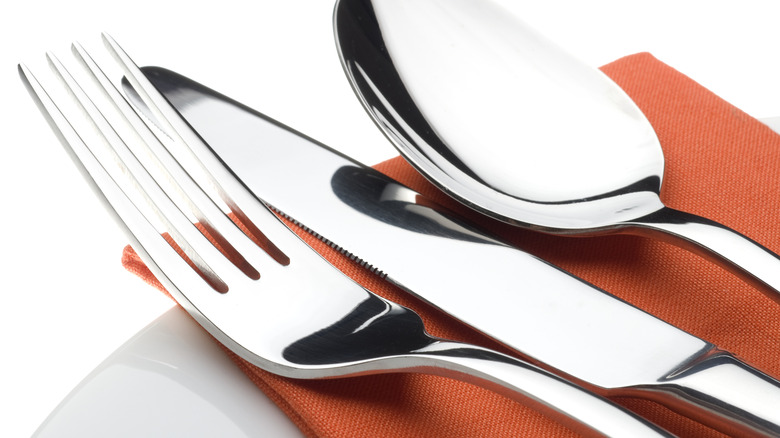12 Little-Known Etiquette Rules For Fine Dining
The 19th century cookbook author Isabella Beeton observed in her famed "Mrs. Beeton's Book of Household Management" that while all creatures eat, "man only dines" (per The Guardian). For her, what distinguished merely eating from "dining" was not only the choice of food, but how it was consumed — for this reason, her instructions on proper dining etiquette were just as detailed as her recipes.
But as you might have suspected, much of what passes for good manners today is based on the random preferences of tastemakers from the past. In medieval England, for instance, nobles ate freely with their hands, and the height of refinement was the ability to avoid dropping food in one's lap. But by the 17th century, expected codes of behavior had gotten so complicated that guests at some events at the French court received written lists of rules upon arrival.Thankfully, it's extremely rare to encounter such rigid rules of conduct today.
But if you visit a fine dining restaurant — especially if your normal restaurant routine is the Starbucks drive-through — you might suspect there are hidden rules you ought to be following. And you would be right. Here are some tips to ensure you make a great impression while enjoying your fine dining experience.
Dress appropriately
First impressions matter in fine dining — as they do in most situations. So if you want to look like you fit in at a fine dining restaurant, be sure to observe the restaurant's dress code. While dining out in casual wear has become the norm in recent years — and many buzzy, cutting-edge restaurants welcome guests in jeans and t-shirts, restaurants are increasingly returning to the old tradition of dress codes, some more formal than others. While part of this is a bit of backlash against diners showing up in their pandemic just-throw-on-whatever clothes, another motivation is restaurant owners wanting diners to see their meals as special events — and dressing up puts diners in the mindset to celebrate.
So if you've been invited to a fine dining restaurant, do your homework first. Most restaurants post their dress codes on their websites, and some explicitly list items they'd prefer that you not wear. However, some common restaurant dress codes are maddeningly vague: What does "casual elegant" mean, and how does this differ from "business casual"? Typically, business casual refers to a practical but put-together look that you'd feel comfortable wearing to work – such as a collared shirt and khakis or skirts. A casual elegant code is a bit dressier — a suit or trousers and sports coat for men or a simple dress with an evening wrap for women.
Keep cell phones, purses, and keys off the table
Part of what makes fine dining special is it's not just about the food or even about reconnecting with those in your dining party — it's about being immersed in the entire, somewhat theatrical experience of the restaurant. This means you and your fellow diners also become part of the restaurant's scenery and contribute to its mood. One way you can contribute to the restaurant's intended mood is to observe its dress code. And another — which will also make the meal more memorable and enjoyable for you — is to stay fully present in the experience.
This means ensuring the dining table is free of anything that can distract you from your meal or companions — so be mindful to keep any personal items, such as your keys, purse, or phone, off the dining table. It will not only create a more pleasant and relaxed experience for you and your fellow diners, but make your server's job easier as well, since they won't have to worry about maneuvering plates and glassware around all your stuff. Generally, this is not the case with casual dining, which so many of us are used to, but it's a must when fine dining. If you absolutely need to take a call or make a call during the meal, excuse yourself and do so away from the table.
Your menu must always touch the table
Many of the rules for fine dining are the same common-sense rules as those for casual dining or eating at home — don't chew with your mouth open, don't reach across the table, be civil to your companions and staff. Others, however, are more obscure, if not outright baffling. Among these is to never lift your menu completely off the table. Even when you're reading it, a part of the menu — be it the bottom corner or the spine — should always remain in contact with the table.
If you're reading this and realizing (with mortification) you've been violating this rule all your life, you're not alone. Nor are you alone if you're wondering what the motivation for this rule could possibly be. And if it's any comfort, even Judith Martin, Miss Manners herself, finds it baffling and unnecessary. "Surely this bizarre directive was intended for children who think it funny to fold their menus over their heads like hats," she wrote to a concerned reader whose nearsightedness made compliance difficult. "While wondering who came up with this unauthorized instruction, Miss Manners can assure you that it does not apply to you."
If you're hosting, set up payment in advance
We've all seen this after-dinner ritual played out: The server brings the check, someone reaches for it, and immediately another alpha male (or female) jumps up to grab it from their hands. While we all appreciate what a gift it is to have generous friends, these scenes are — let's face it — pretty cringy, not to mention a huge waste of everyone's time. And fine dining restaurants in particular are not the place where that kind of noisy (somewhat artificial) drama is welcome.
So if it's your turn to host dinner at a fine-dining restaurant, you should plan in advance to make sure this doesn't happen. Slip your credit card to the host before the others arrive, or to be even more discreet, call the restaurant and share your card information ahead of time. This not only spares your guests the awkwardness of watching you shuffle through your wallet for your card, it can quietly reinforce your role as host. "A savvy host knows to give their credit card before they sit down," etiquette expert Patricia Napier-Fitzpatrick tells Business Insider. "I tell that especially to women who travel to other countries that are very male-dominated."
Allow your guests to order first
Good hosts know their job is to make sure their guests are comfortable and happy. If you're hosting others in your home, you take care to make your home as welcoming as possible and have a generous assortment of food and drink waiting when your guests arrive. And if you're really going the extra mile, you'll be sure to serve dishes you know to be special favorites of your guests.
If you're hosting a get-together in a fine dining restaurant, your job will be a bit easier — your main responsibilities will be identifying a restaurant your guests will enjoy and paying the bill at the end. But as a host, you're still responsible for ensuring everyone has a good experience. You might be in charge, but the event is not about you. So even though you may be starving and absolutely craving everything on the menu, as host, you must allow your guests to order first. This might require you to clarify to waitstaff that you are the host, especially if you're a woman. Say phrases like, "Will you please bring my guest ..." or "My guest would like to order first" to ward off confusion, etiquette expert Patricia Napier-Fitzpatrick explains to Business Insider.
Order the same number of courses as your dining partners
We all know it's frustrating to be the last one at the table to get your food. Or to be long done with your meal while you're watching an especially slow eater peck away at their entree. While there are sometimes legitimate reasons these scenarios can't be avoided, in fine-dining restaurants, guests expect the dining experience to be seamless: Everyone should receive (and finish) their food at the same time, and glitches such as disappearing orders should be exceedingly rare.
But even in fine dining settings, diners can do their part to ensure everyone enjoys their meal. One of these is simple: Be mindful to order the same number of courses as the others in your party. This not only makes things a lot easier and less confusing for your server, but ensures a harmonious rhythm to the meal: No one will be staring at an empty place setting while everyone else eats or awkwardly races to finish eating after everyone else is done. Yes, it's a little unfair that the first person to order gets to set the pace for everyone else, and you may have to order more or less than your appetite requires — but your fellow guests and waitstaff will thank you.
When in doubt about which utensil to use, choose the outermost one
For those of us who didn't grow up taking cotillion classes, one of the most intimidating things about eating in high-end restaurants is dealing with all the silverware. The baffling assortment of forks, knives, and spoons in different shapes and sizes might as well be an assortment of surgical tools. What are they all for, and when are you supposed to use them? In his memoir (and subsequent movie) about growing up poor in Appalachia, now-senator J.D. Vance recounted attending a formal dinner for the first time and upon seeing all the utensils at his place setting, fled the room in a panic and called his girlfriend for help. She calmed him down and instructed him on how to proceed.
What she told him — and what etiquette experts will tell you — is it's no big deal. The silverware is actually arranged in the order in which it's intended to be used. So when in doubt, use the outermost appropriate utensil. For instance, if your first course is a salad, use the fork farthest from your plate — it will typically be a small fork to the left of your plate, with a bigger fork (for the main course) immediately to its right.
Do not ask for an oyster fork
If you've enjoyed fine dining restaurants in the past and have become familiar with what to expect, you may find that some of their weirdness is part of their charm. There's something empowering about dressing up and playing a better version of yourself for a few hours — and after a few visits, all those forks and knives in different shapes and sizes start to feel good in your hands.
Fine dining restaurants, however, do not see a massive assortment of silverware at each setting as a goal in itself. Instead, the goal is to ensure the availability of the appropriate utensil for every course — nothing more, nothing less. For this reason, it's not considered good form to ask for a utensil that's not already provided. So if you order oysters and they arrive without an oyster fork, do not assume it's an oversight. Oyster forks are specifically designed to help you pry the oyster off the shell, and some fine dining restaurants take the extra step of doing this for you before your oysters are served — which means it's a point of pride for the kitchen that no oyster fork is needed. Instead, just use your appetizer fork.
Keep your napkin folded in half, crease toward you, on your lap
One of the first official table manners you probably learned as a child was that your napkin belongs on your lap while you're eating. And of course this also holds true when you're in a fine dining restaurant. But while your napkin will be mostly invisible to other guests during the meal, when and how you position it on your lap matters. At a sit-down fine dining meal, guests are expected to put their napkins on their laps as soon as they're seated (or as soon as the host does so). Your napkin is to be unfolded in a single fluid motion (don't shake it open), then folded neatly in half and placed on your lap with the crease facing you.
During the meal, use the napkin discreetly to gently dab, not wipe, any spills or drips. If you must leave the table, gently fold your napkin and leave it by the left side of your plate. Afraid that your sauce-covered napkin will reveal what a messy eater you are? This is where keeping your napkin folded on your lap comes in — if you've been using your napkin strategically, the bottom half should still be pristine. Simply fold this side over to hide the stains. And if you need to use it again, position the clean half on the bottom to keep your clothes neat.
Be discreet when discussing prices with the sommelier
For many of us, another intimidating aspect of fine dining is the wine menu. If you're not up to speed on all the wine styles and vintages, how they taste, and what they pair with, even a smallish wine menu can be daunting. And even if you spot a humble, familiar wine off the menu, it will cost three times more than what you'd pay for it at, say, Trader Joe's. (It's not because the restaurant is trying to rip you off — paying a trained sommelier, training other staff, and buying and maintaining a professional grade wine refrigerator can be pricy.)
So it's normal to experience some sticker shock when navigating a wine menu at a fine dining restaurant. But while it's okay to have a budget in mind when making your choice, you don't want to kill the mood at your table by talking price with the sommelier. A discreet way to make your requirements known without causing your guests any awkwardness is to quietly point to a wine in your price range and indicate you'd like a hearty red/crisp white in that range.
Don't return wine unless it's seriously bad
You're probably familiar with the clichéd image of a wine snob — a pedant who speaks French and/or Italian fluently and turns their oh-so-well-trained nose up at all but the finest vintages. And of course, a fine dining restaurant would seem to be the natural habitat of such a person. If you find yourself in charge of ordering wine for your party at a high-end restaurant, you might be tempted to channel your inner wine snob in hope of impressing the sommelier and others. But don't — you're not going to fool anyone. "I also tell people not to pretend you're a wine connoisseur, because then you'll look silly," Patricia Napier-Fitzpatrick, etiquette expert, told Business Insider.
Instead, when your wine is brought out, simply taste it. Even if it's not exactly what you expected, "Nine times out of 10, it's just fine," Napier-Fitzpatrick told Business Insider. This is because there's a good chance the sommelier tasted it before bringing it out to ensure it was up to standard. Thus, sending back a bottle in a fit of outrage because it's a bit more tart or tannic than you expected is not a power move — in fine dining contexts, it's rude. Unless the wine is seriously corked or spoiled, consider it yours.
Lay utensils across your plate at the end of the meal
One thing you'll notice at a fine dining restaurant is the relationship between servers and diners is a bit different than you might be used to. While the waitstaff at your neighborhood fast-casual joint may check your table sporadically when they happen to be in the area (or when you call for them), servers at fine dining restaurants are trained to anticipate your needs. They'll watch your table from a distance to determine the pace of the meal, and wait for cues from you before clearing dishes. Unlike waitstaff in more casual restaurants who may be encouraged to turn around tables as quickly as possible, servers in formal establishments put a priority on providing diners with a pleasurable experience.
This means one thing you're extremely unlikely to hear from a server in a high-end restaurant is, "Are you still working on that?" Instead, they'll wait for you to signal you're done. In fine-dining restaurants, there's a standard protocol for indicating you're finished with your meal – placing your fork and knife diagonally across your plate at a 10:20 position. The utensils should be placed together, with the tines of the fork up.

